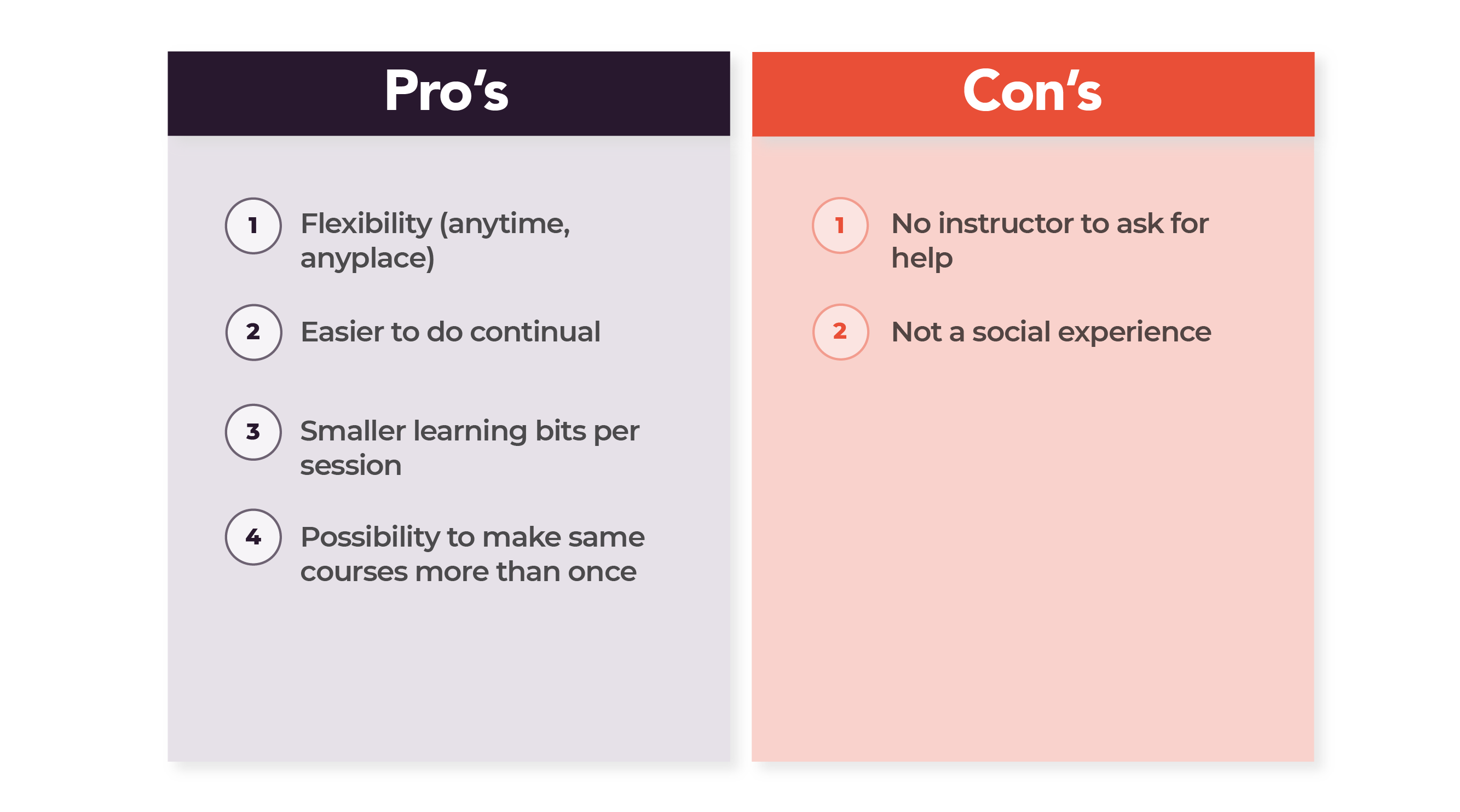We often talk about the importance of security awareness training and GDPR training to improve your organisation’s cybersecurity. While that is an important message, there can still be many things to consider, including ways to deliver your training. In this blog post, I will discuss two different ways to train your team: the traditional, in-person, approach and the online approach, e-learning. This could serve as a guide to help you decide if you should take your IT security and GDPR training online or train your colleagues in person.
Listen to our podcast about the topic
What is traditional learning and what is online learning (e-learning)?
We all know what traditional learning is, as we all remember our younger selves sitting in the classroom, learning history or mathematics from a teacher. In-person learning at work can take place through multiple forms of interactions occurring “in person” between the trainer and the employees. If you were to train your team in IT security awareness in a similar way, you would need to give your employees several sessions that they must attend physically.
Despite what many may think, cybersecurity and GDPR training online does not just provide the same lectures in an online environment. E-learning is more about using various technology and web-based tools to provide training and support learning.
Specifically, it could mean a combination of short readings, videos, and interactive tools (e.g., a quiz, game, or discussion forum), that are all hosted on an online learning platform.

Is online security awareness training better than traditional?
It depends! Both online and traditional forms of learning have their pros and cons and can be used effectively in the right context.
The benefits of traditional learning
For traditional learning, the main benefit centers around the fact that your team and the instructor must physically come together during a predetermined time.
First of all, this means everybody must take one or two hours out of their day and dedicate those hours to training. This ensures that distractions are minimised and that employees can give their full attention to the lesson.
Second, it fosters personal interactions and discussions with the instructor and among the employees. By engaging with the learning content together as a group, your colleagues may learn as much from each other as they do from the instructor. This allows for asking questions directly to an ‘expert’ and immediately clarifying any uncertainties employees might have about IT security or the GDPR.
The downsides of traditional learning
Traditional learning also has some downsides.
For one, it could prove to be very difficult to schedule these physical sessions. Many of us have busy calendars, so finding one or two hours when the entire team is available could be quite a challenge. This does not even include time spent planning the training or setting it up.
Additionally, the number of learners may be too large, or they might be geographically separated. This requires the instructor to hold the same training several times for different groups, which could lead to a sharp increase in costs. Bringing in external experts is often costly and having to hold the same session multiple times could add up.
Lastly, group discussions usually turn into one long monologue from the instructor without much participation or interaction. In other words, the learning quality is very dependent on the instructor’s mood and behaviour as well as the learners’ willingness to actively engage. Many people also struggle to maintain their focus during long classroom learning sessions.

The benefits of online learning
Many of the disadvantages of traditional learning are directly countered by the main advantages of e-learning. Learning about cybersecurity online offers employees flexibility, and online training platforms that are interactive can provide the practical experience that’s necessary for achieving long-term results.
You can give your staff a variety of tools and resources that they can access at the time and place of their choosing. Online courses are often split up into smaller chunks, which allows employees to progress at their own pace, and in accordance with their schedules. This is also known as microlearning, which is a form of learning that is proven to increase information retention.
Through eye-catching graphics and interactive tools like quizzes or simulations, it is also easier to motivate employees and maintain their attention. This encourages staff to engage with the e-learning content on a more continual basis over a longer period, which improves long-term knowledge retention and leads to a deeper understanding of the material.
Additionally, the online learning courses can be reviewed as many times as desired, allowing the employees to refresh their memory when necessary. Many e-learning platforms have options for automation, meaning you can sit back and let the platform send out security training courses and gather the results for you.
Lastly, especially for larger organisations, e-learning has a high return on investment, making it very cost-effective. One e-learning platform can be used to train the entire organisation, often with easy integration of multiple languages.
The downsides of online learning
Just like traditional learning, e-learning also has some drawbacks.
Something we considered when improving our own awareness training is the lack of an instructor, meaning that employees don’t have an expert to consult if questions arise. To solve this issue, we added information boxes with extra guidance on topics that employees might need support in. With courses that are designed and formatted in the right way, employees can progress through the courses on their own without instructor guidance.
Second, the employees learn on their own, so the training may lack interactive discussions. There are of course e-learning platforms with discussion boards or forums, but some people would argue this is not the same as having face-to-face discussions. It is also hard to measure the effect of e-learning. You can read more about measuring the effect of security awareness training here.

How to combine e-learning and traditional learning for security awareness
The type of training that is suitable for you depends on multiple factors, such as the size of your organisation and the other IT security measures your organisation has in place. Your budget is another factor that is likely to have a large impact on what type of security training you want to offer your employees. Regardless of whether you decide to do your training online or in person, training your colleagues will increase their awareness and contribute towards your organisation’s GDPR compliance.
Nevertheless, a relatively easy conclusion to make is that a blended learning approach, i.e., a combination of e-learning and in-person training, would be a safe choice in most situations.
By using online GDPR training, the material can easily be pushed to your co-workers in the most cost-effective way. By pushing new content to the platform periodically, you ensure that everyone continually engages with different learning objectives. Continuous training also increases the likelihood that the information gets ingrained into your team’s mindset in the long term.
E-learning would then be the training standard which can occasionally be supplemented by physical training sessions. These would provide another way for your team to engage with the content they’ve learned from the online courses.
Everyone would get a chance to ask questions and clarify uncertainties. These sessions could also be more practically oriented – putting everything that’s been learned on the platform into practice through e.g., some interactive exercises like role-play.
Take your GDPR training and security awareness training to the next level: long-term learning
Using such an integrated approach provides a very high chance of achieving the security awareness learning goals in your organisation. The reasoning comes down to the science behind what makes people learn new information so that they can remember and use it later. Training by itself, especially in the traditional mode, is not enough to support long-term learning. For learning to happen, training has to be engaging, interactive, and consistent – which is why online GDPR and IT security training works so well.
Simply providing security awareness training is not enough, so we have a guide on how you can transform your training into long-term learning.

Online learning is great for security awareness and GDPR training
Having given a short overview of traditional learning and e-learning, let’s now briefly talk about security awareness training. After all, that is what we’re all about at CyberPilot.
With security awareness training, the main goal is – you guessed it – creating and maintaining awareness about IT security risks and good digital habits. In other words, it doesn’t exactly require a super deep understanding of the subject matter. Your co-workers should simply be aware of the different risks out there and how to deal with them. For instance, they should know about common ways security breaches can happen and how they can avoid them.
Therefore, using an e-learning solution is a good approach to security awareness training and GDPR training. Frequent and small chunks of knowledge that are distributed over time will ensure your team’s awareness is continuously kept up to date. This way, they will always be able to deal with the evolving landscape of cyber threats. Doing your GDPR training online is also a great way to provide just the right amount of GDPR information to your organisation since they don’t need to be legal experts.
Online GDPR and awareness training builds a culture of security
Additionally, security awareness and a basic understanding of the GDPR are essential components of building a culture of security in your organisation. This is another reason why online GDPR and security awareness training is such a great tool for achieving strong security awareness. By letting your team continually engage with fresh learning content about how to recognise phishing emails, how to set up good passwords, how to handle data safely and securely, etc., you ensure that they internalise these good habits in the long term. We cover these topics, and many more in our GDPR and IT security awareness training course catalogue.

Combine online awareness training with phishing simulations to put learning to the test
Finally, integrating some traditional learning elements of course wouldn’t hurt. For example, combining online security training courses with practical exercises, like phishing simulations, ensures your co-workers can act on their awareness in real life and know what real threats look like.
By offering your team GDPR and security training, you are almost guaranteed to make great progress in your journey towards stronger IT security in your organisation.

